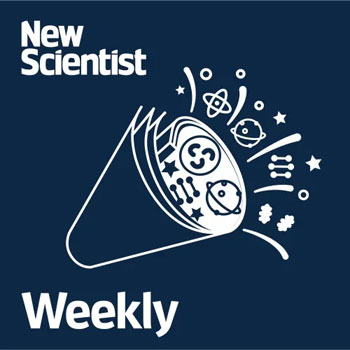
New Scientist launched its first podcast in the mid-2000s, which is pretty much the Jurassic period as far as web content goes. Back then, the podcast was recorded by New Scientist staff and an external broadcaster, and was edited and produced in Los Angeles. The show was a great success in terms of listenership, regularly topping the nascent podcast charts. It was less successful in commercial terms. The management made the decision to halt the podcast and it wasn’t until much later, in 2020, when New Scientist was under new ownership, that podcast production once more got the green light.
The new-born show rapidly took off, charting in the UK top ten of Apple iTunes science podcasts every week. In the Publisher Podcast Awards of 2021 the show won Best Launch and beat off more than 200 other podcasts to win overall Best Podcast. Judges praised the show as “a marvel”, adding: “Although it was faced with formidable competition, this podcast was one of the strongest entries we’d seen. It had excellent alignment with the parent brand, and made good use of staff and magazine content throughout. The production values were also flawless, making it a very enjoyable listen.”
This is how we did it.
The magazine editor asked me at the end of 2019 to take the role of podcast editor and host. My background as a scientist, and as a relative veteran of science writing in general and of New Scientist in particular set me up quite well for the role: I’ve covered many different stories over the years, and have worked on many different projects for New Scientist, including public events. I listened to some of the many excellent science podcasts being made and while I enjoy and value them, I felt there was a gap in the market for us.
I wanted the show to sound like the discussions we have in the newsroom at New Scientist, or even in the pub.
The pub test
I shaped New Scientist Weekly in the image of the magazine. I wanted a show that would be absolutely authoritative, cutting edge and up to date, but accessible. I wanted us to cover the biggest scientific breakthroughs, discoveries and announcements, as well as the quirkier stuff, in a free and easily accessible way. I wanted the show to sound like the discussions we have in the newsroom at New Scientist, or even in the pub. As editors, we sometimes ask reporters, “why do I care about this?”, to get them to hone the pitch of their stories, and we talk about “the pub test”: would you tell your friends about this story in the pub? It’s not the only measure of a story of course, but it is a good way of assessing whether the story is truly compelling. We wanted this to apply to podcast content.
The content had to be delivered colloquially by entertaining and engaging presenters, able to turn scientific jargon into something anyone can understand. Most of the popular weekly shows of this kind are around 25 minutes long, and, accordingly, we set ourselves a show length of 20 to 30 minutes. We wanted to give the show as wide appeal as possible, so rather than cover a single topic in great depth, we gave it more of a “best of the week” feel. That way, if a listener isn’t so interested, say, in a story about quantum physics, they might be more engaged in a subsequent story on dolphin behaviour. We give one line summaries of the upcoming stories in a “contents page” at the start of the show.
Palate-cleansers
We decided to cover five items per show, three in more depth and two more bite-sized. The bite-sized segments were designed to act as palate-cleansers for the longer pieces. We gave these segments names so listeners could start to expect them: ‘Sci-Fi Alert’, when we talk about a story in the science news that has already been predicted or covered in science fiction. ‘Climate Hope or Doom’, where we look at a new piece of climate change research and decide at the end whether the glass is looking more half-full or half-empty. ‘Lifeform of the Week’ covers new research on anything from a newly discovered bacterium found deep underground to a newly seen behaviour in elephants. The framing of stories in this way, particular the climate stories, gave them a lightness of touch and allowed a conversational quality that might otherwise be harder to achieve. Feedback from listeners suggested they appreciated this way of doing stories. On occasion, we break this rule to do special shows focusing on a single topic – usually coronavirus or climate change, but we still have multiple voices and angles into the story to maintain a pace and rhythm.

We started off recording the show in rented studios in central London. We use an experienced freelance podcast producer to edit the audio and add sound effects. We engaged our art director to help develop a strong visual identity for the show. In such an incredibly crowded marketplace, a new podcast needs a very strong and instantly grasped identity and theme. We decided, after much thought, to keep the name New Scientist in the name of the show so as to build on the already very strong recognition of the brand. And we kept the name very simple and direct: New Scientist Weekly.
In our very first show, released January 30, 2020, we discussed the possibility of what was still then called the Wuhan coronavirus going pandemic. In the studio, we would record audio but also video using GoPros around the studio, and capture segments from the speakers to promote on Twitter in order to advertise the show. We’ve experimented putting the shows on YouTube in order to reach that platform’s vast audience, but it’s not a platform we’re using right now.
The framing of stories in this way, particular the climate stories, gave them a lightness of touch.
From studio to bedroom
When the virus did indeed spread around the world a couple of months later, we purchased recording equipment and moved to remote recording using a virtual studio. We chose Zencastr for the stability and ease of use of the platform. Instead of videoclips of speakers, we started using audiograms on Twitter with subtitled clips of thirty seconds or so. We went from recording around a table in a group of four or five, to recording in bedrooms, remotely. This inevitably means there is less spontaneous chat between speakers, and we had to work hard to try and recreate the natural feel of a conversation. We purchased Yeti Blue professional microphones and I use a pop filter too. By finding a quiet space in the house with curtains drawn and soft furnishings – for me that means my daughter’s bedroom – we found we can achieve an almost studio-quality recording.
In such an incredibly crowded marketplace, a new podcast needs a very strong and instantly grasped identity and theme.
Launch
We recorded and edited a pilot episode so we’d all know the set up when it came to the first real episode and to get a more natural feel from the get-go. We launched the show with some in-house advertising and promotion, including print adverts in New Scientist and a campaign on Twitter. We saw download numbers rise rapidly over the first weeks and months. Our download figures peaked just before the first lockdown in 2020, when we did a coronavirus special. After that, as people stopped commuting, podcast listening habits changed and listener numbers levelled off but remained very strong, with the show featuring in the top ten or top five of the UK’s Apple podcast charts every week. The show has now clocked up millions of downloads in over 120 countries worldwide. Key regions, unsurprisingly for an English-language show, are the UK, US and Australia, but the show has fans all over the world. We have a dedicated Twitter account, @newscientistpod, to promote items on the show and to drive engagement with listeners.
It’s a key feature of the show that there is a gender balance to the guests and hosts, and we strive for a diversity in background.
Choosing the guests
We settled into a routine but I wanted to keep expanding and reaching new listeners. One way to do this is to regularly include guests on the show who will then share the podcast with their audience. So we interviewed people with big name recognition, such as Pulitzer-prize winning writer Elizabeth Kolbert, and at the peak of the pandemic, we had former head of the US Centers for Disease Control Tom Frieden. Other big names include the TV naturalist Chris Packham, and the science broadcasters and academics, Professor Alice Roberts and Professor Chris Jackson.
It’s a key feature of the show that there is a gender balance to the guests and hosts, and we strive for a diversity in background. The show mostly takes the form of a round-table discussion, rather than an interview, so it naturally makes the listener feel like part of the conversation – as though they’re sitting in on the discussion. It also allows the audience the chance to consume New Scientist-style content on the move – but it is also highly inclusive and accessible, covering a huge diversity of subjects and with a diverse range of hosts, interviewers and guests.
Keeping it fresh
As well as chats with authors of new science books, we also started doing reviews of big new movie releases that are in the science field, such as the climate change satire Don’t Look Up and the ecological sci-fi epic Dune. Again, the idea is to keep it fresh, to engage with what people are consuming and to expand our range and reach. For the most part, my co-host has been New Scientist news editor Penny Sarchet, but we’ve used a couple of different co-hosts when Penny was on maternity leave.
We’ve started to use auto-generated transcripts of the show which are checked and edited by a human, both to help with SEO and for people who do not want to listen or are hearing-impaired.
We have much more to do to improve the show. But I think my key learning has been to prepare well. We use a script as a framework but the best results are when hosts and interviewees are well prepared and can talk naturally without reading from a script. This gives the show a spontaneity and a freshness but is still very authoritative and authentic. The show has been a great critical and commercial success, generating magazine subscriptions, advertising revenue and greatly expanding and modernising our reach. And there is much more to come.
This article was first published in InPublishing magazine. If you would like to be added to the free mailing list, please register here.










